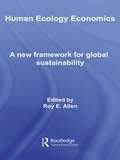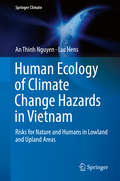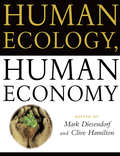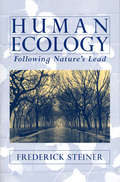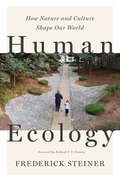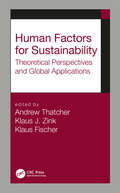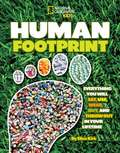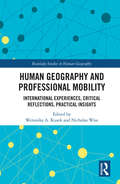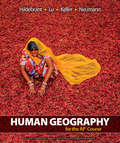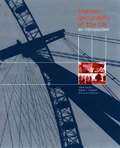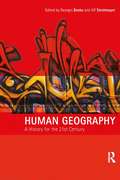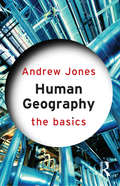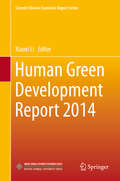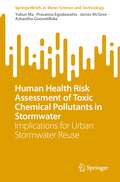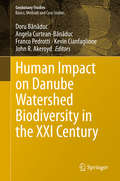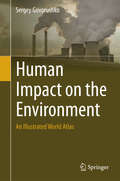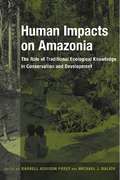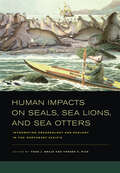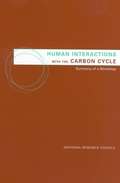- Table View
- List View
Human Ecology Economics: A New Framework for Global Sustainability (Routledge Frontiers Of Political Economy Ser.)
by Roy E. AllenThis book presentshuman ecology economics as a new and more comprehensive interdisciplinary framework for understandingworld conditions and human systems. This book helps economists rethink the boundaries and methods of their discipline - so that they can participate more fully in debates over humankinds present problems and on the ways that
Human Ecology as Human Behavior: Essays in Environmental and Developmental Anthropology
by John W. BennettHuman interaction with the natural environment has a dual character. By turning increasing quantities of natural substances into physical resources, human beings might be said to have freed themselves from the constraints of low-technology survival pressures. However, the process has generated a new dependence on nature in the form of complex "socionatural systems," as Bennett calls them, in which human society and behavior are so interlocked with the management of the environment that small changes in the systems can lead to disaster. Bennett's essays cover a wide range: from the philosophy of environmentalism to the ecology of economic development; from the human impact on semi-arid lands to the ecology of Japanese forest management. This expanded paperback edition includes a new chapter on the role of anthropology in economic development.Bennett's essays exhibit an underlying pessimism: if human behavior toward the physical environment is the distinctive cause of environmental abuse, then reform of current management practices offers only temporary relief; that is, conservationism, like democracy, must be continually reaffirmed. Clearly presented and free of jargon, Human Ecology as Human Behavior will be of interest to anthropologists, economists, and environmentalists.
Human Ecology of Beringia
by John Hoffecker Scott EliasTwenty-five thousand years ago, sea level fell more than 400 feet below its present position as a consequence of the growth of immense ice sheets in the Northern Hemisphere. A dry plain stretching 1,000 miles from the Arctic Ocean to the Aleutians became exposed between northeast Asia and Alaska, and across that plain, most likely, walked the first people of the New World. This book describes what is known about these people and the now partly submerged land, named Beringia, which they settled during the final millennia of the Ice Age.Humans first occupied Beringia during a twilight period when rising sea levels had not yet caught up with warming climates. Although the land bridge between northeast Asia and Alaska was still present, warmer and wetter climates were rapidly transforming the Beringian steppe into shrub tundra. This volume synthesizes current research-some previously unpublished-on the archaeological sites and rapidly changing climates and biota of the period, suggesting that the absence of woody shrubs to help fire bone fuel may have been the barrier to earlier settlement, and that from the outset the Beringians developed a postglacial economy similar to that of later northern interior peoples.The book opens with a review of current research and the major problems and debates regarding the environment and archaeology of Beringia. It then describes Beringian environments and the controversies surrounding their interpretation; traces the evolving adaptations of early humans to the cold environments of northern Eurasia, which set the stage for the settlement of Beringia; and provides a detailed account of the archaeological record in three chapters, each of which is focused on a specific slice of time between 15,000 and 11,500 years ago. In conclusion, the authors present an interpretive summary of the human ecology of Beringia and discuss its relationship to the wider problem of the peopling of the New World.
Human Ecology of Climate Change Hazards in Vietnam: Risks for Nature and Humans in Lowland and Upland Areas (Springer Climate)
by An Thinh Nguyen Luc HensThis book analyzes climate change associated effects in the mountainous and coastal environments of Vietnam. The scope of the book allows international comparisons to be made between these two affected areas and other similarly affected locations under constant environmental pressure. Frequent and intense climate change hazards are described, along with a wider context of integrated interpretations, socioeconomic implications and policy responses. The book reports on original research combining methodologies from the natural sciences with approaches in human sciences, providing an interdisciplinary human ecological context to analyze similar situations worldwide. The book is structured in four parts. The first part offers background information, and details the human ecological framework. The geography of the analyzed regions is discussed to reflect the environmental and socioeconomic context of Vietnam's coasts and mountains. The second part addresses the coast of Central Vietnam. The effects of tropical storms, floods, rising sea levels and coastal erosion in Ky Anh are studied to highlight the impacts on the local population and its development perspectives. The third part focuses on the uplands of Northern Vietnam. The effects of cyclones, heavy rains, floods, flash floods, and landslides in the Van Chan Mountains are studied to compare the biophysical and socioeconomic impacts. Part four makes policy recommendations in building resilient landscapes and green cities, and discusses the potential implications of findings for practice in Vietnam. The book addresses a wide array of researchers, geography and economics students, consultants and decision makers interested in the actual status and the likely developments on the physical, socioeconomic and mitigation and adaptation attitudes and policies of climate change associated effects.
Human Ecology, Human Economy: Ideas For An Ecologically Sustainable Future
by Mark Diesendorf; Clive Hamilton'A brilliant synthesis of ecology and economics that provides a sure guide to a sustainable future. It is a must for all environmentalists and economists.'Charles Birch'Written by an impressive list of experts across a number of disciplines, this readable text provides not only analysis but vigorous criticism-and answers.'Robyn Williams'This book is such a useful guide to responsible decision-making that it should be supplied in bulk to senior government officials and managers in the private sector.'Ian Lowe'This is a fine contribution to ecological economics coming from Australia, and of interest worldwide.'Herman E DalyHuman well-being is wholly dependent upon the continued good health of the Earth s ecosystems. Human behaviour as it interacts with the biophysical environment is enormously complex, as governments (and individuals) who must make decisions about resource use are becoming increasingly aware. Human Ecology, Human Economy provides the basic concepts and tools for understanding how to analyse that interaction.The book is designed to be used as a text for undergraduate and graduate students in environmental studies, human and social ecology, ecological economics, futures studies, and science and technology studies. It is also intended for interested members of the public and for policy-makers working on environmental issues, especially where these intersect with economic policy.Human Ecology, Human Economy not only covers the basic concepts, but also moves to some of the frontiers of thinking in several case studies. It uses a problem and solution oriented approach which crosses disciplinary boundaries, drawing together elements from biology, economics, philosophy and political science.Professor Mark Diesendorf is Director of the Institute for Sustainable Futures at the University of Technology, Sydney and Vice President of the Sustainable Energy Industries Council of Australia. Among the books he has edited are The Magic Bullet and Energy And People.Dr Clive Hamilton is Executive Director of the Australia Institute, Canberra and teaches in the Public Policy Program at the Australian National University. His books include Capitalist Industrialisation In Korea, The Mystic Economist and The Economic Dynamics Of Australian Industry.
Human Ecology: A Theory of Community Structure
by Amos H. HawleyThis volume attempts to develop a full and coherent theory of human ecology. Working from the assumption that there is continuity in the life patterns of all organic forms, the argument begins with the contributions of plant and animal ecologists and seeks to elaborate the logical implications of general ecological theory. This leads to the investigation of a fundamental yet long neglected sociological problem, namely, the nature and development of community structure.
Human Ecology: Following Nature's Lead
by Frederick R. Steiner Richard T.T. FormanIn Human Ecology, noted landscape planner Frederick Steiner presents a historical and analytical examination of how humans interact with each other as well as with other organisms and their surroundings.
Human Ecology: Fragments Of Anti-fragmentary Views Of The World
by Dieter Steiner Markus NauserWe face an environmental catastrophe of global proportions. The ecological rationality of modern society, and of science in particular, is in question. Science still responds to crises at the level of technocratic expertise, and still treats society as an adaptive system. By bringing together a number of integrative approaches to the human-environment problem, Human Ecology shapes a more radical, fundamental agenda for change. The book creates a framework for a cohesive discourse, for a "new human ecology". From the notion that the individual person is an agent mediating between society and environment, the individual contributors recognize that the environmental crisis is really a crisis of society - manifesting itself in an increasing fragmentation of lives in general and knowledge in particular. Arguing for environmentally sustainable lifestyles, the book envisages a new kind of consciousness and a new environment.
Human Ecology: How Nature and Culture Shape Our World
by Frederick SteinerHumans have always been influenced by natural landscapes, and always will be--even as we create ever-larger cities and our developments fundamentally change the nature of the earth around us. In Human Ecology, noted city planner and landscape architect Frederick Steiner encourages us to consider how human cultures have been shaped by natural forces, and how we might use this understanding to contribute to a future where both nature and people thrive. Human ecology is the study of the interrelationships between humans and their environment, drawing on diverse fields from biology and geography to sociology, engineering, and architecture. Steiner admirably synthesizes these perspectives through the lens of landscape architecture, a discipline that requires its practitioners to consciously connect humans and their environments. After laying out eight principles for understanding human ecology, the book's chapters build from the smallest scale of connection--our homes--and expand to community scales, regions, nations, and, ultimately, examine global relationships between people and nature. In this age of climate change, a new approach to planning and design is required to envision a livable future. Human Ecology provides architects, landscape architects, urban designers, and planners--and students in those fields-- with timeless principles for new, creative thinking about how their work can shape a vibrant, resilient future for ourselves and our planet.
Human Environment Interactions - Volume 2
by Michelle GomanThe Holocene is unique when compared to earlier geological time in that humans begin to alter and manipulate the natural environment to their own needs. Domestication of crops and animals and the resultant intensification of agriculture lead to profound changes in the impact humans have on the environment. Conversely, as human populations began to increase geologic and climatic factors begin to have a greater impact on civilizations. To understand and reconstruct the complex interplay between humans and the environment over the past ten thousand years requires examination of multiple differing but interconnected aspects of the environment and involves geomorphology, paleoecology, geoarchaeology and paleoclimatology. These Springer Briefs volumes examine the dynamic interplay between humans and the natural environment as reconstructed by the many and varied sub-fields of the Earth Sciences.
Human Factors for Sustainability: Theoretical Perspectives and Global Applications
by Klaus J. Zink Andrew Thatcher Klaus FischerThis book deals with the central question of how human factors and ergonomics (HFE) might contribute to solutions for the more sustainable development of our world. The contents of the book are highly compatible with the recent political agenda for sustainable development as well as with sustainability research from other disciplines. <P><P>The book aims to summarize and profile the various empirical and theoretical work arising from the field of “Human Factors and Sustainable Development” in the last decade. The book gives a systematic overview of relevant theoretical concepts, their underlying philosophies, as well as global application fields and case studies.
Human Footprint: Everything you will eat, use, wear, buy, and throw out in your Lifetime (National Geographic Kids)
by Ellen KirkMakes you want to step more lightly on the planet! Perfectly timed for Earth Day, this book doesn't preach or judge, but simply shows kids—in an exciting, visual way—how humans interact with the environment and how we can lessen our impact.
Human Geography and Professional Mobility: International Experiences, Critical Reflections, Practical Insights (Routledge Studies in Human Geography)
by Nicholas Wise Weronika A. KusekThis book explores an innovative set of critical narratives, accounts and engagements by different authors about their professional mobility and how that relates to the discipline and their life experiences. Human Geography and Professional Mobility seeks to encourage, influence, and help students understand geographic concepts based on critical reflections, international experiences, and practical insight laid out in stories of real people, real geographers, and real college faculty, that students can relate to. This volume is less theoretical and more personal insight-based, wherein first-hand and personal accounts of practical experiences are explored, which renders the text supplementary reading for human geography, population geography, world geography, and migration/mobility classes. With critical navigation of spaces in response to several geographical questions, this book offers a novel perspective on professional mobility of geographers which will be of interest to students and academics in the fields of geography, tourism, sociology, and anthropology.
Human Geography for the AP® Course
by Max Lu Barbara Hildebrant Kenneth Keller Roderick NeumannStudy, practice, rest. Repeat.Human Geography for the AP® Course by Hildebrant et al, is perfectly aligned to College Board’s APHG® course. It includes all course concepts with plentiful skills support and practice. A complete AP® Practice Exam rounds out the tools in this engaging book program.
Human Geography of the UK: An Introduction
by Eleonore Kofman Irene Hardill David GrahamThis new key textbook for introductory courses in human geography provides first and second-year undergraduates with a comprehensive thematic approach to the changing human geography of the UK at the end of the twentieth and beginning of the twenty-first century. Covering local, regional, national, European and global issues, it also explores in some detail topics which are part of the lived experience of undergraduates themselves, such as crime, unemployment, social exclusion and AIDS.User-friendly textbook features include:* chapter introductions, summaries and important theoretical principles* up-to-date further reading and key on-line sources* case studies, examples and revision questions.
Human Geography: A History for the Twenty-First Century (Human Geography in the Making)
by Ulf Strohmayer Georges Benko'Human Geography' examines the major trends, debates, research and conceptual evolution of human geography during the twentieth century. Considering each of the subject's primary subfields in turn, it addresses developments in both continental European and Anglo-American geography, providing a cutting-edge evaluation of each.Written clearly and accessibly by leading researchers, the book combines historical astuteness with personal insights and draws on a range of theoretical positions. A central theme of the book is the relative decline of the traditional subdisciplines towards the end of the twentieth century, and the continuing movement towards interdisciplinarity in which the various strands of human geography are seen as inextricably linked.This stimulating and exciting new book provides a unique insight into the study of geography during the twentieth century, and is essential reading for anyone studying the history and philosophy of the subject.
Human Geography: The Basics (The Basics)
by Andrew JonesHuman Geography: The Basics is a concise introduction to the study of the role that humankind plays in shaping the world around us. Whether it’s environmental concerns, the cities we live in or the globalization of the economy, these are issues which affect us all. This book introduces these topics and more including: global environment issues and development cities, firms and regions migration, immigration and asylum landscape, culture and identity travel, mobility and tourism agriculture and food. Featuring an overview of theory, end of chapter summaries, case study boxes, further reading lists and a glossary, this book is the ideal introduction for anybody new to the study of human geography.
Human Geoscience (Advances in Geological Science)
by Taikan Oki Yukio Himiyama Kenji SatakeThis book is a product of the joint efforts of interdisciplinary academic fields under the integrative framework of human geoscience. Human geoscience is a new genre of geoscience concerned with the natural phenomena that occur on the surface of the Earth and their relations with human activities. It therefore has connections with many fields of geoscience, namely, physical geography, geomorphology, geology, soil science, sedimentology, seismology, volcanology, meteorology, climatology, oceanography, and hydrology. It also has strong links to the humanities, social sciences, agricultural sciences, and engineering related to disaster prevention or mitigation. All these disciplines are important fields for understanding disasters and global environmental problems and for evaluating the associated risks comprehensively, then proposing mitigation strategies.The volume is designed for those who may not necessarily have a geoscience background but have broad scientific interest in understanding the causes, mechanisms, and consequences of geo-disasters and global environmental problems and wish to make the world more sustainable on that basis. The book consists of six parts: I. Introduction, II. Earth Surface Realms, III. Natural Resources and Society, IV. Natural Hazards and Society, V. Global Environmental Problems, and VI. Global Sustainability Programmes and Human Geoscience, which discusses the contribution of this field of science to a new comprehensive framework for global sustainability.
Human Green Development Report 2014
by Xiaoxi LiThis exhaustive survey assesses the performance of the United Nations and its member states in all key areas, at the same time as laying down a road map for sustainable development in the future. Deploying the Human Green Development Index as a new metric for an era in which human survival is intimately dependent on the viability of the Earth as a clean and sustainable habitat, the report showcases a vast array of data, including HGDI indicators for more than 120 nations. It provides a detailed and comparative rationale for the selection of data for the 12 goals and 54 HGDI targets, which cover human and global needs into the future. The index measures 12 Sustainable Development Goals, based on but also extending the eight Millennium Development Goals defined in 2000. The SDGs, proposed by a high-level UN panel, will supersede MDGs in 2015. They focus on ending poverty, achieving gender equality, providing quality education for all, helping people live healthy lives, securing sustainable energy use, and creating jobs offering sustainable livelihoods. They also work towards equitable growth, stable and peaceful societies, greater efficiency in governance, and closer international cooperation. With indicators covering everything from air particulates to percentage of threatened animal species in a nation's total, and informed by the latest research (with inequality-adjusted metrics for amenities such as education and healthcare), this comprehensive study offers readers not only a wealth of valuable core data, but also a well-argued rationale for using the HGDI. In today's world, we cannot view our development as being distinct from, and unaffected by, that of the Earth we inhabit, or that of our planetary cohabitees.
Human Health Risk Assessment of Toxic Chemical Pollutants in Stormwater: Implications for Urban Stormwater Reuse (SpringerBriefs in Water Science and Technology)
by Ashantha Goonetilleke Prasanna Egodawatta James McGree Yukun MaThis book presents a detailed analysis in relation to human health risk assessment of the main toxic chemical pollutants in urban stormwater generated from urban traffic and land use activities. The knowledge presented in this book was derived based on comprehensive experimental investigations including field sampling, laboratory testing, mathematical modelling, spatial analysis and multivariate and univariate statistical data analyses. The key highlights of the book include the quantitative assessment of the human health risk posed by key toxic chemical pollutants in urban stormwater and the development of linkages between risk and traffic and land use. Additionally, a suite of mathematical equations are presented to predict human health risk based on traffic and land use characteristics through mathematical modelling. These outcomes can significantly assist in effective stormwater risk management under changing traffic and land use in the urban environment. The knowledge presented is of particular interest to readers such as stormwater treatment design specialists, decision-makers and urban planners since these outcomes provide practical suggestions and recommendations for effective urban stormwater treatment design.
Human Impact on Danube Watershed Biodiversity in the XXI Century (Geobotany Studies)
by Franco Pedrotti Doru Bănăduc Angela Curtean-Bănăduc Kevin Cianfaglione John R. AkeroydThe second-longest European river after the Volga, the Danube is one of the world’s most important rivers in terms of its geographical and historical significance. In recent history, it has served as a major international waterway and numerous cities, including four capitals, have been founded on its banks. The 2826km-long Danube has a watershed measuring 801,093 km2 that is now shared between 19 countries, from its source in the Black Forest to the Black Sea, into which it pumps an average of 827 km3 of water a year. This book describes and explains key landscape values interactions (geographical, cultural and natural heritage). It also identifies the threats and various types of human impact affecting this system in all the countries of the Danube River Basin, based on the investigations and perspectives of a team of experienced naturalists, and in the context of the early 21st century, in which the human-nature relationship is still far from balanced. These studies demonstrate how biodiversity, conservation and ecological studies can help us successfully promote mutual cooperation and combine our efforts to address problems as a responsible continent.
Human Impact on the Environment
by Sergey GovorushkoThis atlas presents a collection of geographical maps showing human impact on the environment. A wide variety of human impacts are discussed, ranging from the energy, mining, transport and agricultural industries as well as less visible impacts such as those of space exploration. This book is a highly illustrated atlas with 300 photos from 70 countries. Each map is accompanied by a short description of each human impact and its effect on the specific natural environment.
Human Impacts on Amazonia: The Role of Traditional Ecological Knowledge in Conservation and Development (Biology and Resource Management Series)
by Michael Balick Darrell PoseyFrom the pre-Columbian era to the present, native Amazonians have shaped the land around them, emphasizing utilization, conservation, and sustainability. These priorities stand in stark contrast to colonial and contemporary exploitation of Amazonia by outside interests. With essays from environmental scientists, botanists, and anthropologists, this volume explores the various effects of human development on Amazonia. The contributors argue that by protecting and drawing on local knowledge and values, further environmental ruin can be avoided.
Human Impacts on Seals, Sea Lions, and Sea Otters: Integrating Archaeology and Ecology in the Northeast Pacific
by Torben C. Rick Todd J. BrajeFor more than ten thousand years, Native Americans from Alaska to southern California relied on aquatic animals such as seals, sea lions, and sea otters for food and raw materials. Archaeological research on the interactions between people and these marine mammals has made great advances recently and provides a unique lens for understanding the human and ecological past. Archaeological research is also emerging as a crucial source of information on contemporary environmental issues as we improve our understanding of the ancient abundance, ecology, and natural history of these species. This groundbreaking interdisciplinary volume brings together archaeologists, biologists, and other scientists to consider how archaeology can inform the conservation and management of pinnipeds and other marine mammals along the Pacific Coast.
Human Interactions with the Carbon Cycle: Summary of a Workshop
by Paul C. SternThe results of a November 2001 workshop on human interactions with the carbon cycle are summarized here, focusing on the future of fossil fuel consumption, carbon implications of future land use/land cover transformation, and modeling human interactions with the carbon cycle. There is no subject index. Annotation (c)2003 Book News, Inc. , Portland, OR (booknews. com)
